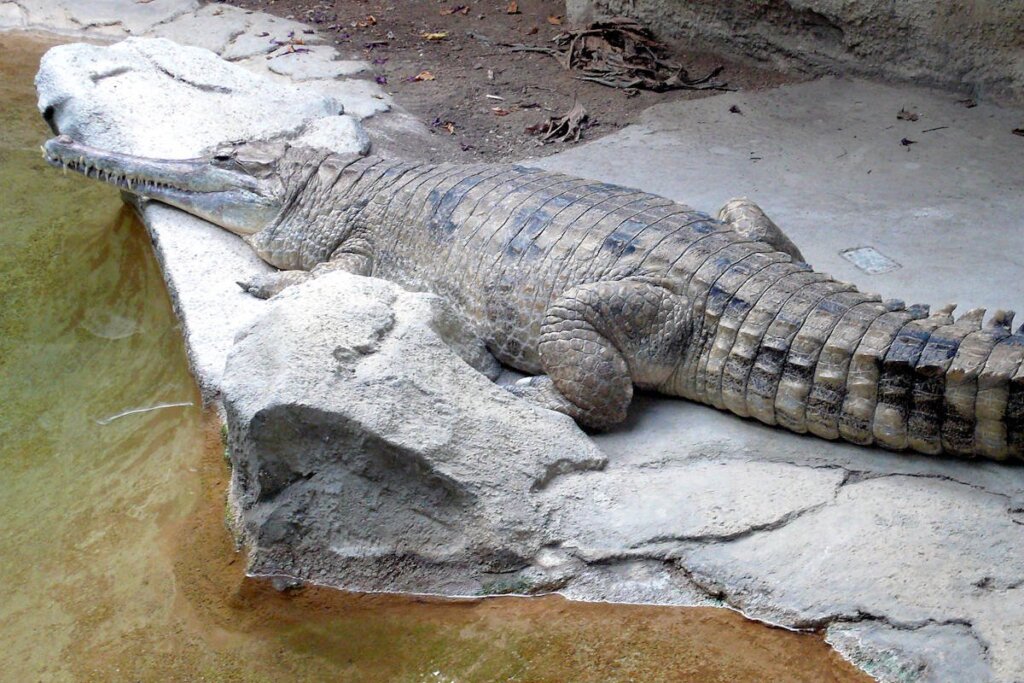Learn all About the Malayan Gharial, a Very Peculiar Reptile

Although it looks like one, it isn’t a crocodile or even a true gavial (Gavialis gangeticus). It’s the Malayan gharial, or false gharial, a huge reptile that lives in rivers and has a really narrow snout. This is its most striking feature, and you will surely recognize it as soon as you see one.
This sauropsid is another animal that is practically unknown and whose life on this planet is threatened. In this article, you can get to know it and its circumstances better. Don’t miss anything, because this is a really special animal from head to tail.
Taxonomy and description
The Malayan gharial (Tomistoma schlegelii) is a species of sauropsid belonging to the order Crocodilia and the family Gavialidae. Gavialids arose in the Eocene, 48 million years ago, and consist of 15 genera, although only two of them have survived extinction to reach the present day.
For many years it was thought to resemble the true gavial by evolutionary convergence, but it was later shown that they belong to the same family.
These reptiles are characterized by a long, narrow snout exhibiting 76 to 84 sharp teeth. They can reach a length of 4 meters (13 feet) and weigh almost 100 kilograms (220 pounds), although even larger specimens have been reported. Males are larger and heavier than females.
Their skin has a dark, greenish-brown coloration, sometimes with dark spots. It’s also possible to see a black band running along the tail and abdomen, although the belly is lighter in color – cream or white.
Habitat of the Malayan gharial
The false gharial can be found in Indonesia, specifically in Kalimantan, Sumatra, Java and Borneo. It also inhabits Malaysia and Brunei, as well as parts of Vietnam and Sulawesi (in the aforementioned Indonesia).
They were formerly also sighted in Thailand, but were exterminated and none have been found since 1970.
Their habitat is the fresh waters of rivers running through swamp forests, flooded forests, peat swamps, lakes, and streams. It’s also possible to see them on the margins of tropical rainforests, where the waters are slow. In fact, they prefer areas with shallow, muddy water, where they can hide more effectively and have a shore for resting and sunbathing.
The Malayan gharial is strictly carnivorous. Their feeding style is opportunistic, as they tend to prey on animals that come to the shore to drink, regardless of the species. They have been sighted catching macaques, deer, dogs, otters, fish, birds, snakes and more.
Their usual strategy is to wait in camouflage near the shore; as their eyes and nostrils are located on the top of their heads, they can see and breathe without surfacing. When their prey approaches, they quickly catch it and dive or slam it to the ground.
It’s rare to find them hunting prey larger than a deer. Their snout is so narrow that there’s a high risk of fracture if they start a fight with large prey.
Malayan gharial behavior
Although there’s a lack of research on the ethology of this species, they’re known to be active throughout the day and take short naps several times throughout a 24-hour period. The Malayan gharial is a solitary reptile and only approaches others to mate.
Except for hunting and mating behavior, there’s little data on how they communicate. It’s assumed that it’s through touch and smell, as sight and hearing are limited by the turbid waters where they usually move.
Mating, moreover, is silent, with no vocal calls to attract each other.
Reproduction
Most details about Malayan gharial reproduction come from captive breeding. Mating and egg-laying occur during the rainy season, when males and females mate several times for about a week.
Females then build a nest in the ground, usually in the shade, using sand and surrounding vegetation. They lay a total of 20 to 60 eggs, which are quite large – 6.2-9.5 centimeters (2.4 to 3.7 inches) – and then cover them with more vegetation.
Sexual maturation is very late: 20 years. Although this is a problem when it comes to conservation, it’s logical for a species that easily reaches 80 years of age.
Conservation status of the Malayan gharial
Currently, this species is in Vulnerable (VU) status and its population has been decreasing for several years. Its threats, of course, come from our species, as its territory is increasingly invaded by agriculture and aquaculture, as well as deforestation.
Sometimes they’re also hunted for human consumption and the use of their parts. Actions taken to address these threats include various environmental protection and awareness programs.
It’s difficult to find empathy for large predators, especially in areas where the general population struggles with poverty and is exposed to the dangers of animals such as the Malayan gharial. Even so, like all natural hunters, they play an indispensable role in the ecosystem and it should never be forgotten that they have the same right to life as any other living being.
All cited sources were thoroughly reviewed by our team to ensure their quality, reliability, currency, and validity. The bibliography of this article was considered reliable and of academic or scientific accuracy.
- Bezuijen, M.R., Shwedick, B., Simpson, B.K., Staniewicz, A. & Stuebing, R. 2014. Tomistoma schlegelii. The IUCN Red List of Threatened Species 2014: e.T21981A2780499. https://dx.doi.org/10.2305/IUCN.UK.2014-1.RLTS.T21981A2780499.en. Accessed on 18 October 2022.
- Tomistoma schlegelii (False gharial, Sunda Gavial). (s. f.). Animal Diversity Web. Recuperado 18 de octubre de 2022, de https://animaldiversity.org/accounts/Tomistoma_schlegelii/
